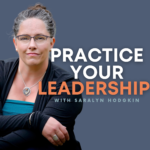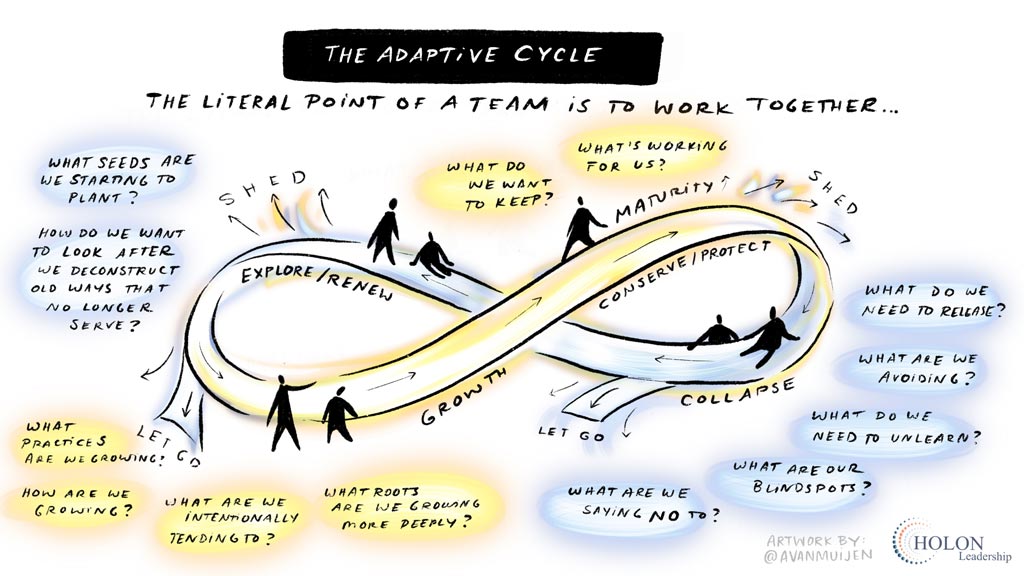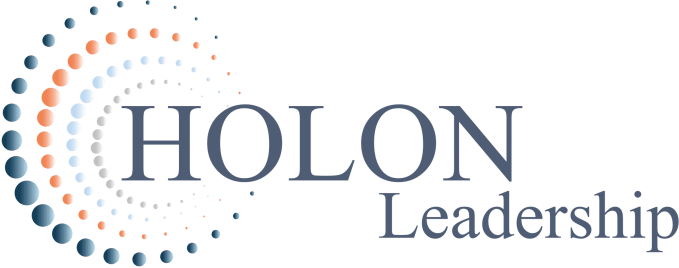Hi, everyone. I’m Saralyn Hodgkin. And this is the podcast to practice your leadership.
Teams learning out loud, part of that work is journeying together, forming teams, riding the waves of change. Seeing team members leave, seeing team members come, seeing pressures on the team. We journey together as a team. And that journey is not just in reflecting on the work, we delivered three workshops, we created these artifacts in the world, we generated this amount of revenue. It’s not just about the external stuff to the team, part of the inner work of teams is journeying together, and reflecting on us as a team. What’s working for us, what’s not working for us in how we align, in how we intentionally behave, and how we centre our relationships.
And so journeying together can really benefit from the ferocity of reflecting, integrating what we learn, experimenting together. Being able to do that in a way where we can we can pivot, where we can learn and adapt to what’s needed now, what’s needed now, what’s needed now. Especially in this time of complexity, especially in this time of complexity, while the work changes, and external externalities come and impact our teams in ways we couldn’t, and can’t imagine, how do we journey together in reflecting on us as a team?
Part of the answer to that, to me, is reflecting intentionally together, here’s number one, reflecting intentionally together. So what does that mean? Something that I offer to a lot of teams is reflecting can sound really nice and verbose. It can sound really effective, and a waste of time. And so when I say reflecting, or being in a reflexive practice, whatever word works for you, right, choose your own adventure on the language, whatever word works for you, it’s about creating a pause and a space to say, what’s been going on that we expected, that we didn’t expect, what are the implications for our team and how we behave, and how we show up, and how we work together.
And now how do we need to be together differently, so that we can move forward. So that we can ride this wave of change, so that we can engage in this piece of work, so that we can show up in front of the board in this united way. Whatever it is, right? Having reflection studios on a regular basis, once a month, once a quarter, definitely once a year, but on a regular basis allows us the time to integrate our collective learning and align on the storytelling that’s happening, versus I have a story in my head about what’s just happened.
And then Person A has had their story. And then Person B has had their story, but we never talk about our stories. And yet it is from our stories, that our inference and our beliefs, sort of guide our actions, guide the nattering of the inner voices in our heads, so let’s create space to share, to collect the learning and stories from the last month, the last quarter, the last significant piece of work.
It also helps keep the team efforts and intentions all pointed in the same direction. When we’re collectively learning and innovating together, sharing in our stories and our truths, it better supports the foundation of us working towards the same goals for which we were formed for as a team. And of course, all of this can then spark more innovation, more brave spaces, more psychological safety, more creativity and conversation and simply what is possible from all this learning.
So, what does a reflection studio hold? What is it, what can that look like? And you can call it whatever you want, you know, I use reflection studio because that resonates for me, but teams you know you can use the language that resonates for you. But one way of holding monthly or quarterly reflections studio is simply: what, so what, now what. I learned this from the developmental evaluation world, what, so what, now what. What are the significant happenings that occurred? You know, like I said earlier, what’s occurred that we expected and didn’t expect from this quarter, from this experience, from this project from you know, however, you’re going to scope it and what are the implications for us as a team now.
There are a lot of ways that you can slice and dice this. So what part: so what? So what if that happened? You can take that into, well, the so what are the implications for the project is bababa. So what are the implications for this is bababa, but part of the inner work of teams is also holding that space in a way where you say, so what that that happened? Well, this is the implications that it’s had on us as a team, we’re completely burnt out. We have no time to seek opportunity. We totally, totally nailed that potential impact. And we got that partner on board, whatever it is, and totally enlivening the team.
Whatever the implications are. The good, the bad, and the ugly, right? What happened in the last quarter on the piece of work? So what – does that have an effect on us as a team? And now what? What, so what, now what? What now? What do we want to do differently as a team? What does that mean for the way that we behave or the language prompts that we have?
So that’s one way to hold reflection studios as a what, so what, now what, bringing some of that conversation to what it means for us as a team. The other tool that can be really helpful is the adaptive cycles. So that sideways, figure eight that many people have seen, to be able to talk through what do we want to conserve as a team and how we operate, how we behave together? And then coming around the other side of that, that figuring out that adaptive cycle leads us into questions about what do we want to creatively destroy? What doesn’t work for us as a team anymore? What are the uncomfortable conversations that we need to have to be able to say, does this work? Does this not work? What is my contribution to that?
Of course, it comes into self leadership work, but as a team, what is it that we’re seeing in this team that we just don’t, we want to throw into the compost pile? We just want to let it go. And then what seeds do we want to plant and how we are as a team, right? And coming around the other side, of course of that figure eight, that adaptive cycle, what are some things that have been cultivated and are starting to grow, that we want to nurture and tend to even more so so that we can start to mature those efforts of us as a team? So the adaptive cycle.
Two other things, one is a no list as a team, in order to hold your sanity, in order to be focused, in order to say no to stuff so you have a lot of space for the stuff that you have a hell yeah for. What’s your no list? Or your not right now list? And do you have it posted up on the wall so the whole team can see it? So the whole team feels the permission to say, I’m not doing that, not doing that? We’ve decided as a team, it’s always a shiny light, all of us want to go to it, but we’ve decided as a team that we have the permission to say no to the efforts that lead us to that whatever that is.
And lastly, hopes and fears. Where are you having conversations with your team, as a team, about what the hopes are from the collective perspective of this team? What are our hopes? What are our fears as a team? The inner work of teams all it takes reflective practice that’s intentional, so that we can collectively learn and journey together.
Thanks all, I’m Saralyn. You can find me at holonleadership.org. I walk alongside you as you practice your leadership.



 Apple Podcasts
Apple Podcasts Spotify
Spotify Google Podcasts
Google Podcasts